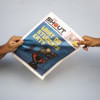Maximalism in Bangladeshi culture and how we make sense of it

Vogue's Architectural Digest videos on YouTube where celebrities give viewers an inside-look into their homes has enticed me for a while. Some of their homes boast very minimalistic settings, in decor and practices, to the point that they seem far too austere to incorporate into my Bangladeshi way of life. As I looked to embrace the noble ethos of minimalism, that one should surround their lives with simplicity and essentiality, the maximalism in our culture became apparent to me.
Maximalism as an art form is the aesthetic of excess, where "more is more". It embraces clutter, excess, mismatched aesthetics, and pieces that have emotional significance or tell a story.
Bangladeshi maximalism is more inherent than intentional. Bangladeshi homes are methodically crammed with souvenirs of the past. At home, my late-grandmother's tableware lies towered besides her old Paan Daan piled alongside everyday tools. My mother's Citycell phone from the '90s is neatly tucked beside an equally archaic cassette player she received as gift from an expatriate relative.
Most households find creative use for disposable commodities. Empty ice-cream boxes and jars may store anything from seasonings to woodwork nails. The austere minimalist interior is quite unfeasible in a Bangladeshi context. For instance, most urban Bangladeshis living with a large family cannot afford having unused open floor plans. How long till someone with a 9 to 5 job, racing against time to avoid Dhaka traffic, becomes exasperated navigating through a home where all essentials are hidden from plain sight in an attempt to declutter?
These theoretically go against minimalist intent – an unobtrusive visual environment, ridden of redundancy, stripped to the bare essentials.
Maximalism extends beyond décor and design. "Bengali Keta" or "Bengali culture of eating" is steeped in it. Our etiquette seeks fulfilment in hospitality. Bangladeshis lay out their fancy crockery and prepare overindulgent servings of food for guests, in amounts that could otherwise sustain a family for days. Panta-Ilish is a traditional dish during Pohela Boishakh and yet the payroll of citizens working in blue-collar professions cannot cover the cost of the expensive Ilish.
Multitudinous maximalism extends to weddings and social celebrations. Inviting everyone-and-their-mother and extravagant hospitality becomes customary to avoid social stigma. Such events need to have the most of everything.
Biriyani must accompany polao and over-the-top arrangements seemingly portray is one's social standing. The older generation still considers empty handed visits from guests and absence of ceremonial presents as a lack of goodwill.
However, maximalism offers our culture exposure at times. For instance, Jamdani, an arduously and intricately designed clothing, weaved by mostly underprivileged weavers, is a luxury item only the financially solvent Bangladeshis can afford and wear on selective occasions. But it has given our heritage international recognition.
The post-liberation war era had inspired expressionistic freedom from dogmatic Pakistani bindings. People embraced psychedelic patterns, exuberant colours, funky and mismatched attires. Current fashion aesthetic still derives its eclectic inspiration from imperial occupation and colonisers. The extravagance and onslaught of colours at Noboborsho or Pohela Falgun celebrations remain unmatched.
While maximalism is known to create wastage and overstimulation, minimalism is accused of stripping away life and unfairly decreeing what's necessary and what's not. And when the boundaries are murky, it's difficult to find a middle ground in an ever-evolving culture.

 For all latest news, follow The Daily Star's Google News channel.
For all latest news, follow The Daily Star's Google News channel. 









Comments